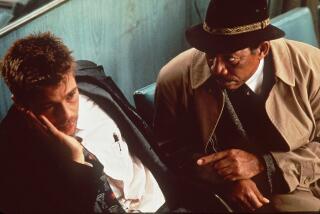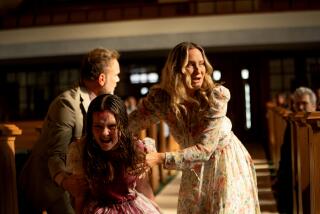William Friedkinâs memoir makes a strong âConnectionâ with film
William Friedkin is sorry. In his new memoir of a career in the directorâs chair, heâs sorry he almost got that stunt driver on âThe French Connectionâ killed. Heâs sorry he fired all those cinematographers, except for the ones who deserved it. He must be sorry he directed âDeal of the Century,â or heâd have found someplace in the book to mention it. And he canât be too proud of the three ex-wives, or heâd have given them each their own sentence, instead of making them share.
Friedkinâs not sorry he became a director, though â just amazed. âThe Friedkin Connectionâ chronicles his unlikely rise from the child-welfare rolls of Chicago, where nobody handed him anything, to the stage of the Dorothy Chandler Pavilion, where in 1972 Frank Capra handed him an Oscar for directing âThe French Connectionâ and told him he deserved it.
Friedkin didnât believe him and spent the next decade or more trying to prove Capra wrong. Soon he was blowing millions of Universalâs money building one bridge for the movie âSorcererâ and burning another with every tantrum he threw.
âHubris had overcome me,â Friedkin writes, sounding uncannily like a defendant in a show trial. Too much of âThe Friedkin Connectionâ has that same predigested quality, but staying up late with his new memoir, as with most of his movies, itâs hard to look away.
Friedkinâs autobiography represents a triumph of irresistible material over slightly pedestrian style, but most of his movies work the opposite way. âThe French Connectionâ looked like just another cop movie until Friedkin floored it, shooting on the fly and cutting it all together like calculated agitprop. âThe Exorcistâ (1973) had all the makings of a modest, atmospheric, RKO-style horror film â until Friedkin piled on unprecedented visual and, especially, sound effects.
Forty years on, what jumps out at you about these back-to-back blockbusters is their near-hysteria. Oneâs about heroin addiction, the other demonic possession, and Friedkin can definitely relate. He came off like a monster in Peter Biskindâs book about Friedkinâs â70s filmmaking cohorts, âEasy Riders, Raging Bulls,â but these early pictures arenât expressions of his personality so much as denials of it. The stories feel arbitrarily chosen, mere pretexts for the Friedkin treatment. Why this cop? Why this little girl, and not the girl next door? Both movies are based on novels, based in turn on real life, suggesting that Friedkin hadnât yet found stories of his own to tell.
Biskind played up the directorâs machismo, his megalomania and misogyny. Friedkin himself doesnât dwell on those qualities, but he doesnât disavow them, either. It would be folly to try. Friedkinâs nihilism is all over his work, especially âThe French Connectionâ and âThe Exorcist.â In both films the bad guy gets away, free to deal drugs or steal souls another day.
For all Biskindâs addictive anecdotes, that book leaves off before Friedkin may have actually started to grow up. Arguably his best two movies, âTo Live and Die in L.A.â and âSorcerer,â came midcareer. The first of these takes a daring, vertiginous swerve near the end, promoting its sympathetic sidekick into the protagonist. Itâs tempting to think that Friedkinâs better angels too were finally beginning to supplant his more destructive side.
Some of the best passages in the book pay tribute to a few of Friedkinâs mentors and friends: the Chicago news cameraman Bill Butler, who wound up shooting âJawsâ; the documentary producer David Wolper, whose sweatshop also nurtured Friedkinâs great screenwriter Walon Green; Sonny Bono (honest!), whom Friedkin fondly makes into an endearing cross between Mozart and P.T. Barnum; and loyal, gnomic Harold Pinter, whose play âThe Birthday Partyâ gave Friedkin his first serious critical success on film.
Belatedly, becomingly, Friedkinâs gratitude for a career in movies has only grown. He started out a Jewish dead-end kid. With hard knocks behind him, who can begrudge Friedkin love beyond his wildest deserts with fourth wife Sherry Lansing, the equally memoir-worthy Paramount CEO and beloved den mother to a generation of female executives? Wags had a field day with the one-liners, but Friedkin sounds smitten 22 years later. In more ways than one, Friedkin knows whatâs good for him.
He once told Biskind he considers most contemporary Hollywood movies âgarbage,â a line that probably did his career as much harm as any of his early bad behavior. He tries unconvincingly to walk it back here, but his old signature intensity is everywhere today, from bad movies like âSawâ to good ones like âUnited 93.â
Love him or write him off, nobody can say Friedkin doesnât adore movies. Anybody whoâs listened to his besotted commentary track for the Val Lewton horror classic âThe Leopard Manâ knows that. An 80-page chapter just on âThe French Connectionâ? Catnip to film hounds and probably more credible than anything Friedkin would say about the ex-wives. Those of us whoâve done a little ghostwriting have a maxim: May as well leave out the stuff youâd only lie about anyway.
The most heartfelt, dramatic writing here comes when it counts, way back in 1980, as a coronary lands Friedkin in the ER at Cedars.
âDying,â he thinks. âMy God, Iâm dying. Iâve wasted my life. I havenât accomplished anything.â
The chapter is operatic, but it plays. Friedkinâs losing the light, but he gets the shot.
Kipen is a film and book critic and founder of Libros Schmibros, a nonprofit lending library in Boyle Heights.
The Friedkin Connection
A Memoir
William Friedkin
HarperCollins: 512 pp., $29.99
More to Read
Sign up for our Book Club newsletter
Get the latest news, events and more from the Los Angeles Times Book Club, and help us get L.A. reading and talking.
You may occasionally receive promotional content from the Los Angeles Times.







